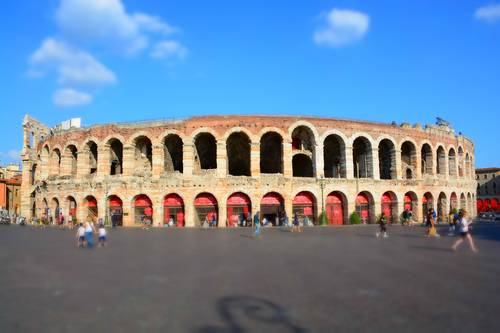Verona
The jewel on the Adige
Verona is worldwide known thanks to Shakespeare, who created a parallel between the Guelfi-Ghibellini fights and his own Romeo and Juliet. Furthermore, the town owes its fame to the lyric arts festival which brings together in the famous space of the Roman arena the lovers of Verdi’s Opera. Verona’s historical centre was recognized in 2000 as part of the Unesco Heritage. The town is first and foremost a beautiful place in which, from the medieval churches to the squares sided by palaces in pink marble, dominates the soft harmony of a Renaissance hanging between Lombardia and Veneto.

Piazza delle Erbe – CC BY-SA 3.0 | Fabio Becchelli | 2008
Departure is planned at 8 in the morning, and the bus will be waiting at the cross between Paleocapa Street and Jacini Street.
Once in Verona, visit to the Church of San Zeno Maggiore, masterpiece of Romanesque architecture, with precious bronze doors and, inside, above the main altar, the splendid triptych by Mantegna (1459).
Castelvecchio is the main monument belonging to the medieval civil architecture of the town; wanted by Cangrande II della Scala between 1354 and 1357. The complex entails two cores, separated by a crenelated bridge. The core on the left, the old realm, became home to Cangrande II after the traditional realms in the square dei Signori were abandoned; its shape is trapezoidal and it has two courtyards and a double circle of fortified walls with two drawbridges. The core on the right, meant to be used by the mercenary troops, has a rectangular map and is circumscribed by a simple crenelated curtain with angular towers, and holds the main courtyard. It also hosts the Museo Civico di Verona, which preserves important works painted by the Venetian School between the 14th century and the 18th century, such as masterpieces by Stefano da Verona, Altichiero, Pisanello, Andrea Manegna, Jacopo e Giovanni Bellini, Paolo Veronese and Tintoretto. Illustrious is the collection of sculptures, among which stands out the Statua Equestre di Cangrande I coming from the Arche Scaligere.

Castelvecchio – CC BY-SA 2.0 | BestKevin | 2008
The most renowned monument is certainly the Arena, one of the major surviving Roman amphitheatres in the world, erected in the 1st century and capable of hosting 22.000 people.
We move on to the visit of the historical centre, plentiful of gorgeous palaces, like Palazzo Bevilacqua and Palazzo Canossa, designed by the Sanmicheli, and of churches, as the Duomo, S. Anastasia and S. Fermo Maggiore. The Duomo is a Romanesque building with gothic and Renaissance assimilations, while S.Anastasia is a gothic church, built entirely in cotto tiles. S.Fermo Maggiore is made up of two overlapping buildings; the lower one is Romanesque and dates back to the 11th and 12th centuries, while the upper part is gothic and dates back to the 14th century.

Arena – CC BY 2.0 | Paul Arps | 2015
Lunch is individual.
The living core of Verona is Piazza delle Erbe, which occupies the ancient roman forum. On the square are situated the Case Mazzanti (the Urbs Picta), painted by Alberto Cavalli, who was the fellow student of Giulio Romano. Together with Piazza delle Erbe, also Piazza dei Signori is a lively element of the town, as in it are placed some of the main public institutions, such as the Palazzo della Prefettura, the Palazzo del Capitano, the Loggia del Consiglio and the Palazzo della Ragione, the last currently hosting the Galleria d’Arte Moderna and recently restored by the architect Tobia Scarpa. In the Palazzo della Ragione modern and minimal features are harmoniously combined with the ancient architectures, with the famous Cappella dei Notai, which is a jewel of the Baroque painting from Verona. Beside the Palazzo della Ragione is placed a beautiful square hosting the Romanesque small church of S. Maria Antica and the notorious Arche Scaligere, the monumental tombs of the lords of Verona. Surrounded by fence in iron which dates back to the 14th century, the tombs have the shape of niches with precious gothic canopies at the top, decorated with the statues by the campionesi masters (14th century).
Once passed the bank of the Adige, visit to the Italian style garden of Palazzo Giusti, which is an archetype for the Renaissance gardens, with fountains, caves, mythological statues and labyrinths. Then, visit to the Chiesa di Santa Maria in Organo, Romanesque, with a Renaissance façade done by Michele Sanmicheli and with marvellous tarsie decorating the stalls of the choir and a crypt with roman columns.
The arrival to Milan is planned by 8,30 PM.